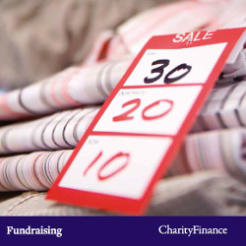The last year saw the slowest growth in the the charity retail sector in more than a decade, according to figures published in the Charity Shops Survey 2015.
The exclusive research will be published on 1 October by Charity Finance and Fundraising Magazine, the sister titles of Civil Society News. The annual survey has tracked charity shops’ income and profit over the last 24 years.
Among charities completing the survey both this year and last, income rose by 2.6 per cent, while profit is up just 1.4 per cent.
The figures refer to charities' latest financial years, which are mostly to December 2014 or March 2015.
The growth in profit is the smallest in the last decade. In 2006, profit rose by 3.2 per cent, and since then charities have enjoyed annual profit growth of up to 14.3 per cent.
Changes in income and expenditure
Charities’ sources of income saw large swings.
Charity retailers identify the price of recycled clothing, or rag, as their largest single concern, just as they did the previous year. The price dropped sharply in 2014, and is continuing to fall further.
Income from rag fell 13 per cent year-on-year, and there is evidence that charities are carrying out fewer door-to-door collections as a result.
The survey also collected figures on charity retailers’ most common concerns. These suggest a higher level of worry about rag prices than there has been about any other issue at any time in the last ten years.
Income from donated goods rose modestly, but gift aid income rose considerably, indicating that shops are getting better and better at claiming gift aid. Sales online rose fast, as did sales of new, bought-in goods.
Charities’ expenditure rose by 2.9 per cent, just slightly more than income.
Staff costs rose by 5.6 per cent, rent by less than 1 per cent.
Staff costs have risen by more than inflation for several years. Rent, on the other hand, has consistently increased by less than either income or profit.
Shop numbers up again
Shop numbers continue to rise, and are up by 1.7 per cent this year – the 12th successive year in which numbers have grown - but the increase is slower than in previous years.
The sector is still dominated by big chains. The largest ten charities have around 4,700 shops – two thirds of the total surveyed – and the single largest charity, the British Heart Foundation, has 11 per cent of the total.
Charity shop managers still expect to increase shop numbers, however, with 66 per cent predicting growth, and only 8 per cent predicting that numbers will drop.
Positive interpretation
Andrew Hind, outgoing editor of Charity Finance, wrote in the foreword to the report that while shops are seeing a significant slowdown, this could be viewed in a positive light.
He said that the past decade shows that shops have their best years when times are difficult for charities, and that as the economy recovers, a slowdown should be expected, but shops have already done their most valuable work.
“Firstly shops are a wonderful source of unrestricted income at a time when such funds are like gold dust for most charities,” he wrote. “Then there is the fact that there is an inverse correlation between shops profit and the wider economy.
“When times are tight and both voluntary donations and government funding are under pressure or in decline, people are spending more on second hand goods in charity shops. This is a priceless commodity from the perspective of any charity fundraising or finance director.
“So as the British economy emerges from the doldrums of the last six years, it is perhaps not surprising that the results from charity shops trading are less hot than they have been in recent times.”
League table little changed
This year’s survey includes 75 charities which between them have 6,626 shops – the largest ever sample of shops. Between them those shops contributed more than £828m to the sector, including a contribution of £194m – a profit margin of around 23 per cent.
The top ten charities remained almost unchanged, with the British Heart Foundation remaining the largest, shortly followed by Oxfam (see list below). The main change is that Marie Curie enters the top ten this year, and the PDSA drops out.
- British Heart Foundation (735 shops) - income £172.7m profit £34.4m
- Oxfam (660 shops) - income £93.1m, profit £29.8m
- Cancer Research UK (574 shops) - income £78.4m, profit £25m
- Sue Ryder (458 shops) - income £57.9m, profit £13.4m
- Barnardo’s (590 shops) – income £57m, profit £11.3m
- Age UK (425 shops) – income £45m, profit £6.5m
- Salvation Army (200 shops) – income £43.4m, profit £11.8m
- British Red Cross (319 shops) – income £29.4m, profit £6.7m
- Scope (237 shops) – income £22.5m, profit £3m
- Marie Curie (193 shops) – income £17.5m, profit £3.2m
- Subscribers to Charity Finance and Fundraising magazine will receive a copy of the Charity Shops Survey with their October issue. Online subscribers will also be able to read it on the website from 1 October. Click to find out more about subscription options or to purchase a standalone copy.








